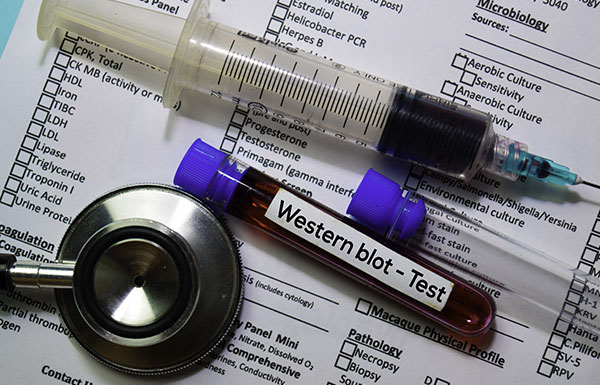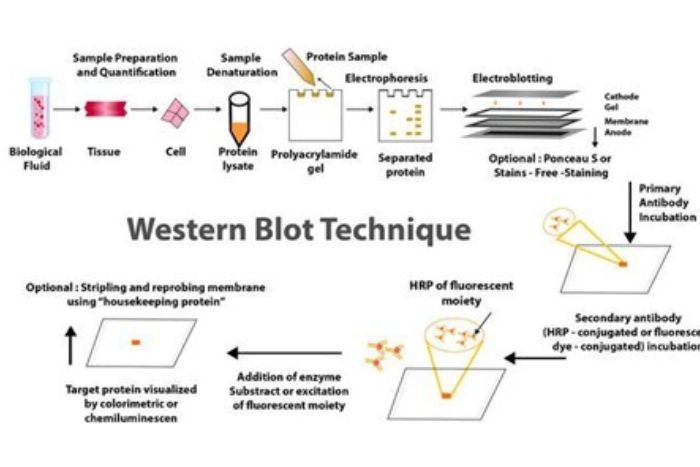Difference between line blots and Western blots

What is western blot?
Western blotting is also called Protein Immunoblotting because an antibody is mainly used to detect its antigen. It is a widely accepted analytical technique used to detect specific proteins in the given sample.
Western blot is generally used in research to separate and identify proteins. This technique separates a mixture of total proteins based on their atomic weight, and hence by type, through gel electrophoresis. The result is then transferred to a membrane producing a band for each protein.
The Western blotting approach is used to find proteins from crude mixtures. At first, the proteins are separated by gel-electrophoresis into bands. All of the proteins are then transferred to a membrane, where the target protein band is identified with primary antibodies.
The Target protein is more specific. Such primary antibodies on the membrane will be detected with secondary antibodies, either enzymatic or fluorescence-labelled. Other interrelated techniques include dot blot analysis, quantitative dot blot, immunohistochemistry and immunocytochemistry. In all these techniques antibodies are used to identify proteins in tissues and cells by immunostaining and enzyme-linked immunosorbent assay (ELISA).
Immunometric assays, also known as sandwich ELISAs, use two antibodies precise to the antigen to capture antigens for detection.
Western blotting workflow
Proteins combined with nitrocellulose have a minor effect on protein activities. Moreover, the membrane is inexpensive, easy to use and produces minute non-specific staining.
2. Blocking: In a western blot, it is crucial to block unreacted sites on the membrane. It reduces the amount of unspecific binding of proteins, following steps in the assay using inert protein or nonionic detergent.
3. Primary Antibody Incubation: Blocking, a primary immunodeficiency antibody specific to a target protein it is nurtured with the membrane. Moreover, the primary antibody combines to target protein on the membrane. In western blot, the primary antibody should be confirmed before use. If the target epitope is destroyed, the blot results will be influenced.
4. Secondary Antibody Incubation: Rinsing the membrane to remove unbound primary antibody, the membrane is exposed to a definitive enzyme-conjugated antibody. Moreover, the secondary antibody binds to the primary antibody, which has cross-reactivity with the target protein.
What is line blot?
Line blots are immunoassays in which antigens are placed precisely on nitrocellulose as narrow lines. The line blot is an immunoassay for monoclonal and other antibodies. It is an application to the serotyping of gram-negative bacteria.
A procedure is described for blot assay antibodies based on antigens to nitrocellulose as a line with an ink pen point. This is often done in the lab using a ruler to guide and measure precisely where the antigens are placed. If performed commercially, they are always striped on to the same part of the nitrocellulose strip during the automated process.
Workflow of a Line Blot
● The Line immunoblot test is a membrane-based enzyme immunoassay for the semi-quantitative determination of IgG antibodies. It is proximate to several nuclear antigens (ANA) in human serum or plasma. The blot test is used for various diagnoses of rheumatic diseases and immune deficiencies.
● Purified antigens are deposited as bands onto nitrocellulose strips. An enzyme-catalyzed substrate reaction for detection stains the bound antibodies.
● The Line blot is an essential and easy-to-use test system for discovering autoantibodies. It is typical of various rheumatic autoimmune diseases; sometimes, the autoantibodies act as specific antibody markers for sole diseases.
● The test is incredibly valuable for comparing the autoantibody profile after ELISA screening or the immunofluorescence tests to increase specificity.
Line blots work in a very similar way to Western Blots as far as the assay itself. It is the blot preparation that is different.
Benefits of a Line Blot?
● Line blots are much easier to read as the strips (antigens) are always in the same place.
● Reading of line blots is not so subjective and hence requires less specialized interpretation.
● The band’s strength generally tends to be consistent and more substantial than Western Blots.
What is the difference between line blot and western blots?
Western blots, in contrast, diffuse antigens in polyacrylamide gel by electrophoresis. A negative charge is applied to the gel. The native proteins, which are made up of amino acids, carry a net negative charge when at a pH above their Isoelectric point (pI). As a result, the proteins migrate up the gel, which acts as a molecular sieve. Due to their molecular size, smaller proteins find more space in the gel to migrate further. On the other hand, larger proteins tend to get blocked at an earlier stage in the gel.
So a particular protein, HIV p26, for example, will travel a certain length up the gel. Gels made are not always the same; the migration length can differ slightly from a specific selector. This makes some bands harder to distinguish, and interpretation more subjective, which can lead to indeterminate results. However, blot manufacturers usually provide a guide or template to enable easier interpretation.
Is Western Blot technology a thing of the past?
Western blots have always been considered as the Gold Standard for the detection of antibodies to HIV. It provides more information on the status of a disease, based on the relative strength of the protein bands that develop. The challenge here is that it’s harder to interpret, which can lead to indeterminate results.
Idealists prefer Western blots; the legal impacts of false negatives or false positives, have become more of an issue in recent times. Younger scientists often seem to prefer Line Blots as the lines require less interpretation.
To learn more about western blots and line blots, contact Helvetica Health Care today.

